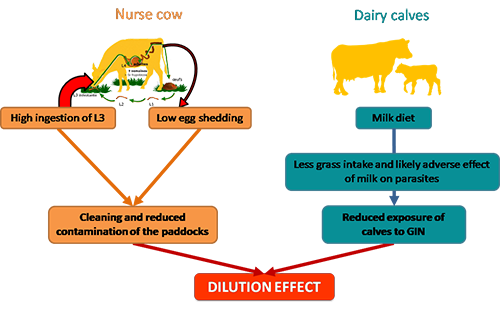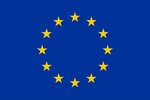Parasite infection risks for dairy calves raised by nurse cows studied in France
In dairy farms, new rearing practices of calves with nurse cows have been developed by farmers. As a part of the GrazyDaiSy project, three different parasite indicators were measured individually in 438 calves belonging to 38 groups at housing in western France. The results suggest that rearing suckling dairy calves with nurse cows decreases the level of gastrointestinal nematode infection in calves at the end of the 1st grazing season.

The rearing of dairy calves with nurse cows has been implemented by farmers and is increasingly widespread in the West part of France, particularly in organic farms. This technique is perfectly suited to highly grassy systems on organic farms where calves have a long first grazing season with their nurse. Infections by gastrointestinal nematodes (GIN) are very common in grazing cattle in temperate regions. However, no study is available on the dairy calves/nurse cows system on pasture regarding GIN infection; thus, the objective of this study was to assess the impact of such a management on the GIN infection of calves.
Study design
The study sample included 38 groups of calves reared with nurse cows from 30 organics dairy farms located in the northwest of France (464 calves and 204 nurse cows in total). These calves were mainly cross-bred (83 %). The number of calf per group varied from 2 to 39 (average 12.2) and the number of nurses per group varied from 1 to 18 (average 5.4), with a mean ratio of 2.6 calves per nurse. Only 17 calves (3 %) were treated with anthelmintics during the grazing season. Blood and faecal samples for each calf were collected at the end of the grazing season (from the end of October 2018 to mid-January 2019)
The GIN egg excretion level was determined in each faecal sample (Cringoli et al. 2017). Individual serum pepsinogen concentrations were determined according to Kerboeuf et al. (2002). To estimate in each group the pasture infectivity level, i.e. the level of GIN infective larvae on pasture, a model was used (Parasit’Sim) (Chauvin et al. 2009). The pasture infectivity was modeled by calculating the number of biological Ostertagia cycles (= larval generation) realized since turnout on each paddock, taking into account local daily average temperatures and the grazing management practices described for each group.
Grazing management and parasitic indicators
32 groups were composed of calves mainly born in spring and six groups of calves born in the autumn. The mean duration of the grazing season was 195 days (70–302 days). Calves were mainly weaned at housing, except in five groups where the weaning took place during the grazing season (from May to October) with a post-weaning grazing period without nurse cows afterwards. Continuous grazing was used for only three groups whereas 14 groups grazed on successive paddocks without return and 21 groups were conducted on rotational grazing. Thus, the majority of the dairy calves raised with nurse cows had a long first grazing season and a turnout at an early age compared to conventional system where heifers graze alone (Merlin et al. 2016).
By modelling the grazing management using Parasit'sim, two-thirds of the groups (26 /38 groups) met at least the 4th larval generation during their first grazing season which is normally considered as a high risk situation (Chauvin et al., 2009; Merlin et al., 2017). The average values per group of serum pepsinogen were low (1.12 U Tyr) compared to other studies on dairy heifers in their first grazing season in organic or conventional farms: 2.4 U Tyr and 2.0 U Tyr respectively (Merlin et al. 2018). Lastly,the egg excretion level was in the lower range of what was observed in other studies in suckler or dairy herds (Shaw et al. 1997; O’Shaughnessy et al. 2015).
Hypothesis of a dilution effect
Egg excretion level and pepsinogen values measured in our study indicated a low GIN infection when calves are reared with nurse cows. Globally, our results suggest that the presence of the nurses could have a diluting effect on the parasitic risk to the calves.
Nurses cows, that have acquired immunity against GIN, would ingest large number of larvae from the pasture but would excrete only small amounts of eggs. They would therefore have a kind of sanitizing effect on the paddocks. In addition, since the calves are not weaned, they drink milk from the nurse's udder, thus ingesting less grass and would therefore be less exposed to the larvae present in the paddock. Furthermore, ingestion of milk by calves during the grazing period could have an adverse effect on parasite infection as it has been demonstrated in lambs with O. circumcincta (Zeng et al., 2001).
Chauvin A, Vermesse R, Lardoux S, Masson M & Ravinet N (2009) Parasit’Info: un système expert d’aide à la gestion du risque des strongyloses disgestives et de la fasciolose en élevage bovin. Le Point Vétérinaire 40, 29–30.
Cringoli G, Maurelli MP, Levecke B, Bosco A, Vercruysse J, Utzinger J & Rinaldi L (2017) The Mini-FLOTAC technique for the diagnosis of helminth and protozoan infections in humans and animals. Nature Protocols 12, 1723–32.
Kerboeuf D, Koch C, Le Dréan E & Lacourt A (2002) Méthode simplifiée de mesure de la concentration en pepsinogène dans le sérum. Revue Médecine Vétérinaire 153,707–712.
Merlin A., Chauvin A., Lehebel A., Brisseau N., Froger S., Bareille N. & Chartier C (2017) End-season daily weight gains as rationale for targeted selective treatment against gastrointestinal nematodes in highly exposed first-grazing season cattle. Preventive Veterinary Medicine, 138, 104-112.
Merlin A., Chauvin A., Madouasse A., Froger S., Bareille N. & Chartier C (2016) Explaining variability in first season grazing heifer growth combining individually measured parasitological and clinical indicators with exposure to gastrointestinal nematode infection based on grazing management practices. Veterinary Parasitology, 225, 61-69.
Merlin A., Ravinet N, Madouasse A, Bareille N, Chauvin C & Chartier C (2018) Mid-Season targeted selective anthelmintic treatment based on flexible weight gain threshold for nematode infection control in dairy Calves. Animal 12, 1030–40.
O’Shaughnessy, J, Earley B, Mee FL, Doherty ML, Crosson P, Barrett D & De Waal T (2015) Nematode control in suckler beef cattle over their first two grazing seasons using a targeted selective treatment approach.Irish Veterinary Journal 68.
Shaw, DJ, Vercruysse J, Claerebout E, Agneessens J & Dorny P (1997) Gastrointestinal Nematode Infections of First-Season Grazing Calves in Belgium: General Patterns and the Effect of Chemoprophylaxis. Veterinary Parasitology 69, 103–16.
Zeng S, Lawton DEB, Przemeck SMC, Simcock DC & Simpson HV (2001): Reduced Ostertagia circumcincta burdens in milk-fed lambs, New Zealand Veterinary Journal, 49, 2-7.
Authors
Constancis Caroline, Leligois Morgane, Bareille Nathalie, Chauvin Alain, Chartier Christophe, Ravinet Nadine
BIOEPAR, INRAE, ONIRIS, 44300, Nantes, France, caroline.constancis@oniris-nantes.fr
More information:
Risk of gastrointestinal nematodes infection during the first grazing season of dairy calves raised by nurse cows in organic farms (article in PDF)
Editor: Karin Ullven / Design: Christine Dilling
